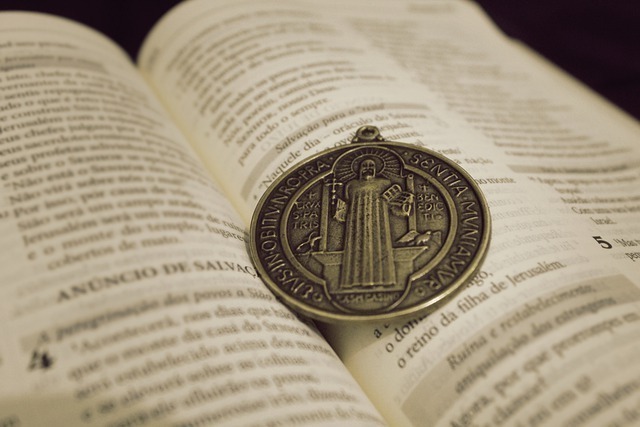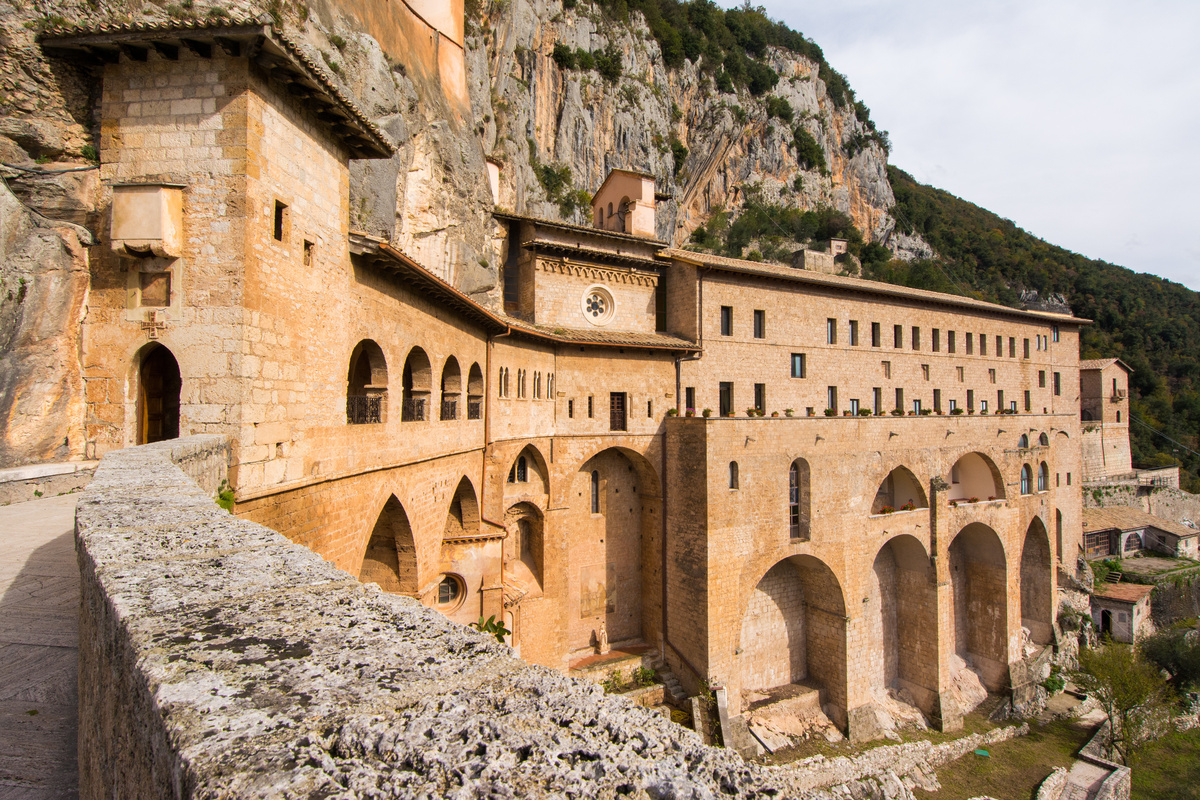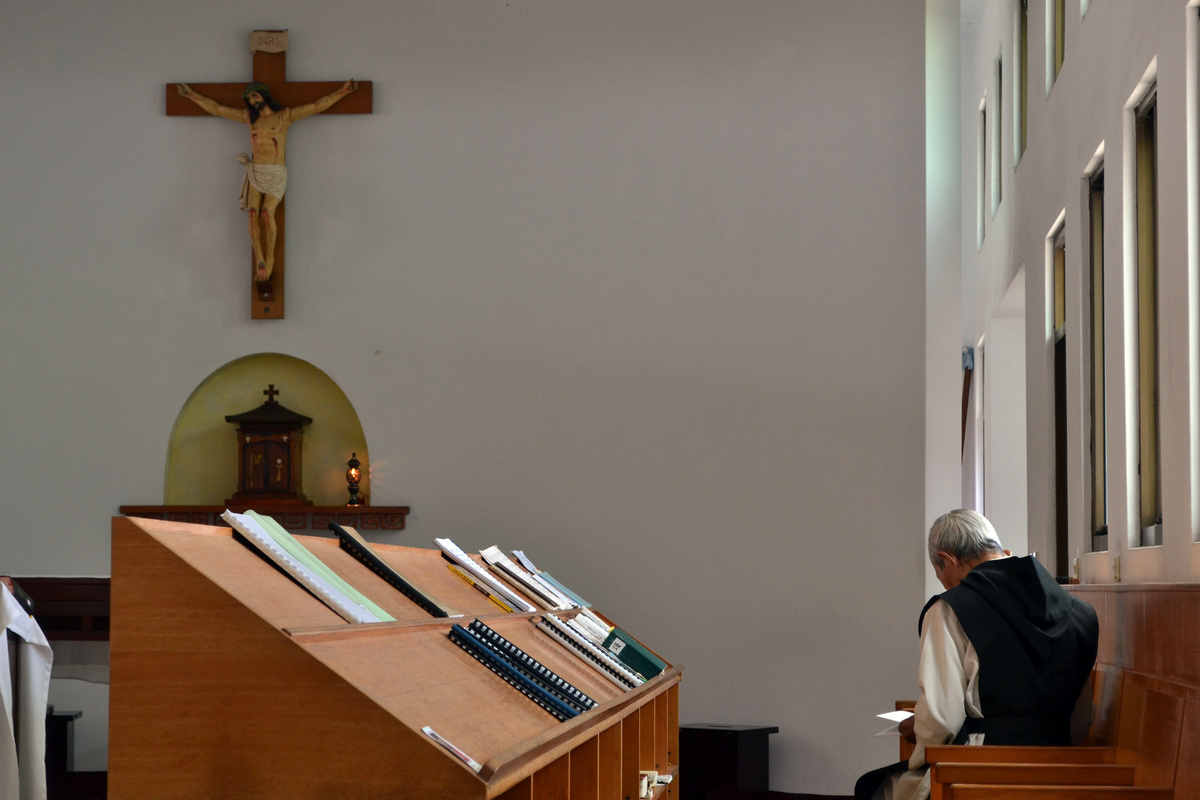Table of contents
Who was Saint Benedict?

Saint Benedict, an Italian monk from Norcia, was the one who started the Order of Saint Benedict, also known as the Benedictine Order. In addition, he also wrote the Rule of Saint Benedict, a book that is considered to be a guide for the creation of monasteries.
Born in Norcia-Italy in the year 480, he was from a prosperous family of the region, had a twin sister named Scholastica, who was also canonized. In his studies St. Benedict was instructed in the humanities, moving to Rome at the age of 13 with a governess.
However, he felt disappointed with his studies, abandoned school and decided to devote himself to God. He then left Rome with his governess in search of isolation. On this journey, he crossed the city of Tivoli and at the end of the day arrived in Alfilo, where he stayed.
It was in this place that St. Benedict began to attract attention. The story goes that he collected the shards of a broken clay vessel while he said his prayers, and those present tell that the vessel was being rebuilt without showing any cracks. This was the beginning of the story of the powers of St. Benedict.
History of São Bento

The story of Saint Benedict is filled with difficult decisions, betrayals, assassination attempts and envy. But it also has the side of kindness, charity and willingness to help others. Saint Benedict was a person who sought to do the best for people and for faith.
In this part of the article you will learn a little more about the life of Saint Benedict, the attempts to assassinate him, the first monastic order founded by him, his rules, his miracles and devotion to this saint.
Life of St. Benedict
When people learned of Saint Benedict's manifestation of power, they began to follow him, both out of curiosity and veneration. Then Saint Benedict decides to take refuge, leaving his housekeeper and with the help of a monk who lent him a friar's habit.
He then spent three years sheltering in a cave, in Subiaco, in the year 505, living as a hermit. After this time of prayer, Saint Benedict returned to community life with the intention of creating a new way of governing religion, which did not take away the right to live the pleasures of friendship.
Around the age of thirty, St. Benedict was invited to coordinate a colony of monks. He then made an attempt to put his new ideas about religion into practice. However, due to the rigidity of his leadership, there was an attempt to poison him. But as he blessed the cup of wine with poison, the cup broke.
Saint Benedict then took refuge again in Subiaco, in the company of other monks who supported him and who built 12 monasteries in the region. Each monastery would house 12 monks, under the direction of a dean, and these monasteries would answer to a central monastery.
However, the initiative of Saint Benedict is not well seen by a priest of the region, for seeing his faithful going to the monasteries. So, the priest begins to make intrigues and slander Saint Benedict and also tries to poison him, but he does not succeed.
Saint Benedict then, decides to go to Monte Cassino, and by 529 founds a monastery, which later would be known as the first monastery of the Order of Saint Benedict. For the creation of this monastery, Saint Benedict proposes a project that aims to shelter refugees, with an adequate lodging for these people.
Attempted murder
Because he had become famous for his holiness, St. Benedict was invited to direct the convent of Vicovaro. He accepted, for he wished to be of service, but did not agree with the life led by the monks of the monastery. The monks' works were not unconditional, as St. Benedict believed the following of Christ should be.
Thus, the religious began to create an antipathy against St. Benedict, leading them to try to poison the saint. However, the attempt was unsuccessful, because when blessing the cup of wine given to him with poison, it shattered. From this moment he left the convent and returned to Mount Subiaco.
The first monastic order in history
After his second refuge at Mount Subiaco, Saint Benedict with the help of other monks founded 12 monasteries in the region. Before the creation of these monasteries, the monks lived in isolation, as hermits in solitude.
Saint Benedict was responsible for organizing the life of the monks in monastic communities and so the monasteries began to be born. The families of the Roman nobility began to send their children to study in the monasteries of Saint Benedict, which had Saint Mauro and Saint Placidus as teachers.
The Rule of St. Benedict
St. Benedict wrote a book about how community monastic life should be organized, called Regula Monasteriorum. His book with 73 chapters came to be known as the Rules of St. Benedict. The book prioritized rules such as silence, prayer, work, recollection, fraternal charity, and obedience.
It was from his book that the Benedictine Order, or Order of St. Benedict, was born. They are still alive today and follow the rules written by St. Benedict over 1500 years ago. In addition to governing the monasteries of St. Benedict, his rules have also been adapted for other congregations of monks.
Miracles of Saint Benedict
Saint Benedict began to be known for his miracles at the inn he stayed at in Alfilo, by remaking a broken clay vessel with his prayers. Another of his miracles was his own deliverance from poisoning, by blessing the cup and shattering it.
In addition, in his preaching of the Gospel to the community of Monte Cassino, he performed several exorcisms, and thus the people began to convert. It was then that the people of the town decided to tear down the temple of Apollo and on its ruins they built two convents.
Devotion to Saint Benedict
In the year 547, on March 23rd, Saint Benedict died at the age of 67. Days before his death, foreseeing what would happen, for he was quite ill, Saint Benedict asked the monks to open his grave.
Saint Benedict was canonized in the year 1220, part of his relics are in the Monastery of Monte Cassino, and part in the Abbey of Fleury, in France.
Saint Benedict medal and its message

The medal of Saint Benedict is a symbol of faith, used with the intention of obtaining the protection of the saint, it should not be seen as a good luck charm. In his medal there are numerous representations about his miracles and faith.
In this part of the article you will find information about the various inscriptions on and around the faces of the medal and their meanings.
In front of the medal
According to history, the medal of St. Benedict was first carved in the monastery of Monte Cassino. The medal of St. Benedict has on its sides written in Latin.
On the front of the medal there is a cross with the initials CSSML, which means "The sacred cross be my light" and NDSMD, which means "Let not the dragon be my guide". Around the front of the medal are the letters CSPB which means "Cross of the Holy Father Saint Benedict".
In addition, on the top of the cross of the medal, is engraved the word PAX, which in Portuguese means Peace. This is also the motto of the Order of St. Benedict. This word can also sometimes be replaced by the monogram of Christ: IHS.
Inscriptions on the inside of the reverse side of the medal
On the inside of the back of the medal is the image of Saint Benedict, who holds in his left hand the book of the Rule made to organize the community of monks, in his right hand he holds the cross. Around the saint we read the phrase "Let us be comforted by the presence of Saint Benedict at the hour of our death".
Still on the back of the medal of St. Benedict is the chalice, from which comes out a serpent and a raven holding a piece of bread in its beak. This is the symbol that brings to mind the two assassination attempts that St. Benedict managed to save himself miraculously.
Inscriptions around the back of the medal
In addition to the inscriptions and images on the front and back of the Saint Benedict medal, there are also inscriptions around it. This inscription is the longest of them, and features the holy name of Jesus, in the monogram known to all: IHS "Iesus Hominum Soter", which translates as "Jesus Savior of Men".
After this, there is the following writing made clockwise: "V.R.S N.S.M.V S.M.Q.L I.V.B" these letters are the initials of the following verses:
"Vade retro Satana; nunquam suade mihi vana: Sunt mala quae libas; ipse venena bibas." which means "Withdraw, Satan; never counsel me vain things, it is evil what you offer me: drink your poisons yourself."
Symbolism in the image of Saint Benedict

The image of Saint Benedict is also the representation of facts occurred during the life of this saint. There are several symbols that talk about his rules, the assassination attempts, his life in the desert among other representations.
In this part of the text find the meanings of each of the symbols present in the Image of Saint Benedict as, his habit, the cup, the book, the staff, the gesture of blessing and his beard.
The black habit of São Bento
The black habit of Saint Benedict, or the black cassock, represents the Benedictine Order which was founded by the Saint in the middle ages. After spending three years of his life as a hermit on Mount Subiaco in prayer, he went to live in the Vicovaro convent.
When he left the convent, he founded the Order of St. Benedict, following the inspiration brought to him by the Holy Spirit. The black habit of St. Benedict is still worn today by his confreres in Benedictine monasteries.
The Saint Benedict Cup
Continuing with the meanings of the image of St. Benedict, now we will see what the meaning of the cup in his image. Each of the objects that make up the figure of this saint has a symbolism that reveals some passage or achievement in the life of St. Benedict.
The cup present in his image speaks of two important and serious events in the life of this saint. It represents the two assassination attempts on Saint Benedict, both by poisoning, one by monks from the Vicovaro monastery and the other by a priest from the Monte Cassino region, both motivated by envy and pride.
The book in the hand of Saint Benedict
Another important symbol present in the image of Saint Benedict is the book he carries in his left hand. It carries the memory of the book written by the saint, by divine inspiration, which later became the rule for the life of the monks of his Order.
The book has clear, simple but complete rules, which guide the work of the Benedictine monks until today. Briefly the rules speak about prayer, work, silence, recollection, fraternal charity and obedience.
The staff of Saint Benedict
This symbol in the image of Saint Benedict, the staff he carries, has the meaning of father and shepherd, which the saint represented to the faithful in his time. After founding the Order of Saint Benedict, the saint became a father to thousands of monks.
Due to his deeds, kindness and charity, Saint Benedict has been followed in his footsteps throughout religious history. In addition, the staff is also the symbol of Saint Benedict's authority, as the creator of the Order and also for his walk taking faith and light to thousands of people.
The gesture of Blessing
In the image of Saint Benedict he always appears making the sign of blessing, this represents a constant action in the life of the saint, blessing people. This is because he followed the teachings of Saint Peter, who said, "Do not repay evil for evil, nor injury for injury. On the contrary, bless, for to this you have been called, that you may be heirs of the blessing".
It was by following this teaching to the letter that Saint Benedict managed to get rid of two attempts at poisoning. By blessing those who tried to kill him, he was saved by a miracle.
The beard of Saint Benedict
Saint Benedict, despite having given up his studies at a very young age to live in dedication to the works of God, was a man of vast wisdom. This wisdom also forms part of the representations of his image.
Saint Benedict's beard, which appears long and white in the image, is symbolic of his wisdom, which was his guide throughout his life. It was because of this wisdom that he founded the Benedictine Order which helped millions of people from all parts of the world.
The devotion to Saint Benedict

St. Benedict's charity, wisdom and commitment made him a person who received much devotion from the people who followed him. Both the monks and the faithful who followed him had great devotion and respect for the saint.
In this part of the article know other information about Saint Benedict as, its miracles, the day of commemoration of the saint and its prayers.
Miracle of Saint Benedict
According to the story, Saint Benedict performed his first miracle in Alfio, in the inn where he was staying. While he was saying his prayers, he collected the pieces of a broken vessel, and when he finished collecting the shards, the vessel was whole and without cracks.
After this episode, he performed another miracle that saved his life, for pride and envy the monks of the monastery Vicovaro tried to poison him with a cup of wine. But when blessing the drink the cup broke. In addition, Saint Benedict was also responsible for several exorcisms in the region of Monte Cassino.
The day of Saint Benedict
Saint Benedict was born on March 23, 480, and died on July 11, 547 and it is on this date that the Saint's day is celebrated. Saint Benedict was named on this same day as the patron saint of the Catholic Church, and also of Europe.
This saint is very popular among the faithful and is also well known for his medal, which has many meanings for the people who carry it with them. People who are devoted to Saint Benedict and his medal venerate them with great faith until today.
Prayer of Saint Benedict
St. Benedict for his faith and charity was a miraculous saint and helped people a lot in his time. Therefore, there are several prayers to ask for graces to this saint, know some of them below.
Prayer of Saint Benedict
"O God, You who deigned to pour upon the blessed confessor, the Patriarch, the spirit of all the righteous, grant to us, Your servants and handmaids, the grace to put on that same spirit, so that we may, with Your help, faithfully fulfill what we have promised.Through Jesus Christ our Lord.Amen!"
Prayer of Saint Benedict to obtain graces
"O glorious Patriarch Saint Benedict, who always showed yourself compassionate to the needy, grant that we too, by having recourse to your powerful intercession, may obtain help in all our afflictions. May peace and tranquillity reign in families; may all misfortunes, both corporal and spiritual, especially sin, be removed. Obtain from the Lord the grace we implore of you, obtaining for usfinally, that at the end of our life in this vale of tears, we may praise God. Amen".
Prayer of the Medal of Saint Benedict
"The Holy Cross be my light, let not the dragon be my guide. Retreat, Satan! Never counsel me vain things. It is evil what you offer me, drink your poisons yourself! The blessing of Almighty God, Father, Son and Holy Spirit, descend upon us and remain forever. Amen".
What is the importance of Saint Benedict?

Saint Benedict was a very important saint during the period of the Middle Ages, it was he who founded the Benedictine Order. The rules written by him that gave rise to the organization of the Order of Saint Benedict, were also used by other monasteries for their organization.
The existing rules in his book, which served as a guide for the creation of the monasteries and of his Order were: silence, prayer, work, recollection, fraternal charity and obedience. Not to mention all the benevolence preached and carried out by Saint Benedict.
In today's text we tried to leave all the information about the life and works of St. Benedict, we hope it has help to remove your doubts and to know this saint better.

